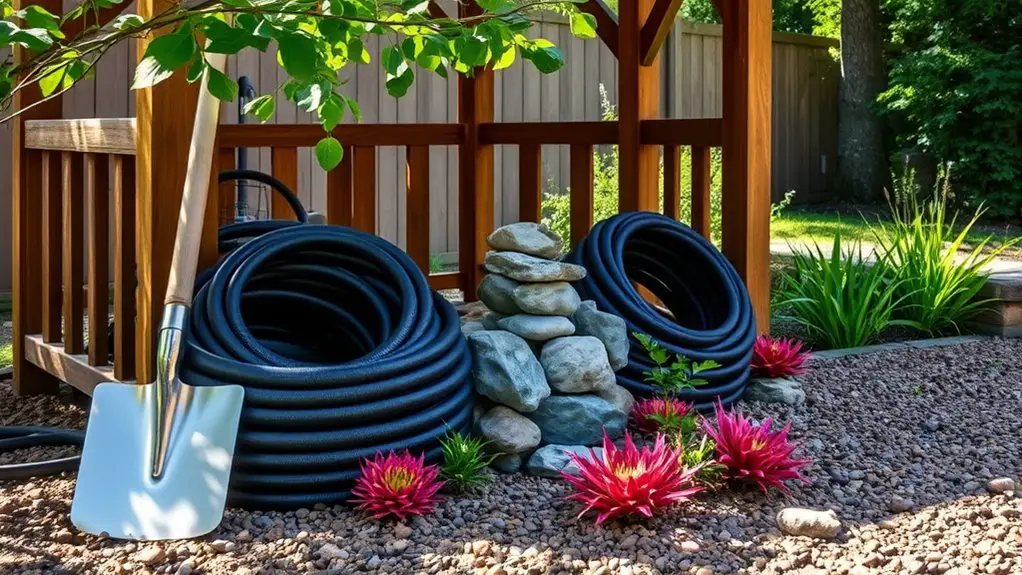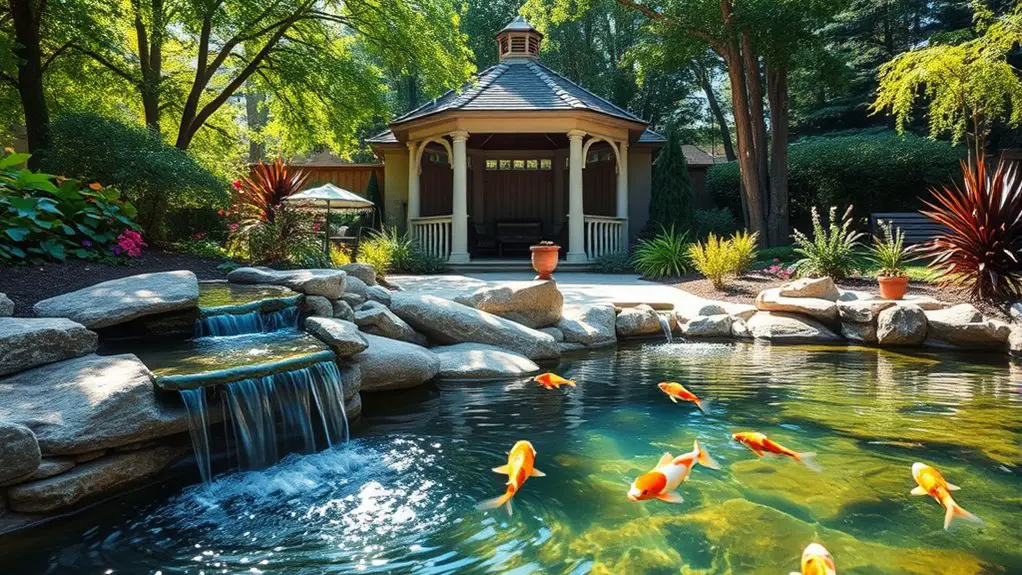To install a pond or water feature near your gazebo, first choose a spot with balanced sunlight and proper drainage. Plan your design, considering shapes and depths that complement your landscape. Gather high-quality materials like pond liners and pumps. Excavate the area, install the liner, and set up the circulation system. Regular maintenance is vital for aesthetics and health. Follow these steps closely to create a stunning feature, and you’ll discover even more essential tips ahead.
Choosing the Right Location for Your Pond or Water Feature

When you’re deciding where to place your pond or water feature, have you considered how sunlight and shade will affect its ecosystem? Sunlight exposure plays an essential role in maintaining water temperature and supporting plant growth. Ideally, you want a balance; too much sun can lead to algae blooms, while too much shade can hinder plant photosynthesis.
Also, drainage considerations are important. Verify your chosen location has proper drainage to avoid overflow during heavy rain. Sloped areas can help direct water away from your pond, preventing erosion and sediment buildup.
Observe your yard throughout the day to determine sunlight patterns and identify areas with consistent shade. By carefully selecting a location based on these factors, you’ll create a thriving aquatic environment that enhances your outdoor space and nurtures local wildlife. Make certain your pond is a harmonious addition, flourishing under the right conditions.
Planning Your Design and Size
Having identified the right location for your pond or water feature, the next step is to plan its design and size. Consider the pond shape that complements your gazebo and overall landscape. Common shapes include circular, rectangular, or freeform designs. Each shape offers unique aesthetics and functionality.
Next, determine the water depth. A depth of 2-3 feet is ideal for fish, while shallower areas support aquatic plants. Here’s a quick reference table to help you visualize your options:
| Pond Shape | Ideal Size (ft) | Water Depth (ft) |
|---|---|---|
| Circular | 6-10 | 2-3 |
| Rectangular | 8-12 | 2-4 |
| Freeform | Varies | 1.5-3 |
| Square | 6-10 | 2-3 |
| Kidney | 8-12 | 2-3 |
Gathering Necessary Materials and Tools

Before you plunge into installation, it’s vital to gather all the necessary materials and tools to guarantee a smooth process. Start with high-quality pond liners; they’ll form the foundation of your water feature, preventing leaks and ensuring longevity. Choose liners that are durable and suitable for the size of your pond. Next, you’ll need a reliable water pump to maintain circulation and keep your water clear. Look for pumps with adjustable flow rates to customize your feature’s ambiance.
Don’t forget essential tools like a shovel for digging, a level for ensuring evenness, and a hose for filling your pond. Additionally, consider decorative stones or gravel for aesthetics and filtration. By assembling these materials and tools beforehand, you’ll empower yourself to create a stunning and tranquil oasis near your gazebo, enhancing both your space and your freedom to enjoy nature.
Installing the Pond or Water Feature
As you commence on the installation of your pond or water feature, it’s crucial to start by outlining the layout. Visualize where you’d like the water to flow and consider the pond depth, ensuring it’s suitable for your chosen plants and fish. Follow these key steps for a successful installation:
- Excavate the Area: Dig out the pond shape, varying the depth for aesthetics and to provide diverse habitats. Aim for a minimum depth of 18-24 inches for stability.
- Install the Liner: Lay down a durable pond liner to prevent leaks. Smooth out any wrinkles and secure the edges with stones or soil.
- Set Up Water Circulation: Incorporate a pump and filtration system to maintain water circulation. This will keep your pond clean and oxygen-rich, crucial for any aquatic life.
Landscaping Around Your Water Feature

Landscaping around your water feature can transform it into a stunning focal point in your garden. Start with thoughtful plant selection; choose native aquatic plants and perennials that complement the water’s edge. Varieties like irises and ferns not only beautify but also support local wildlife. Consider layering plant heights to create depth and interest.
Incorporate natural stones or gravel around the perimeter to enhance the feature’s organic feel. Lighting options play a vital role too; strategically placed solar lights can illuminate the water feature at night, creating a serene ambiance. Use underwater lights to highlight fish or plants, adding an enchanting touch.
Finally, don’t forget about pathways that lead to your gazebo, ensuring they’re lined with soft, fragrant flowers. This cohesive design invites you to relax and enjoy the freedom of your outdoor haven, turning your water feature into a harmonious blend of nature and tranquility.
Maintaining Your Pond or Water Feature
To keep your pond or water feature thriving, establishing a regular cleaning schedule is essential. You’ll also need to monitor water quality, as it directly impacts the health of aquatic life and the overall aesthetic. By prioritizing these maintenance tasks, you can guarantee your water feature remains a vibrant focal point in your landscape.
Regular Cleaning Schedule
Maintaining a regular cleaning schedule for your pond or water feature is essential to its health and aesthetic appeal. By establishing a consistent cleaning frequency, you can keep algae at bay and enhance the overall beauty of your outdoor space. Here’s a simple plan to follow:
- Weekly Inspections: Check for debris and algae growth. Remove any floating leaves or organic waste.
- Bi-weekly Algae Removal: Use a skimmer or net to eliminate algae buildup, ensuring your water remains clear and inviting.
- Monthly Deep Cleaning: Drain a portion of the water, scrub surfaces, and clean filters to maintain peak water quality.
Water Quality Management
While you might think that a pond or water feature requires little more than aesthetic appeal, managing water quality is essential for sustaining its ecosystem and ensuring a healthy environment for aquatic life. Regular water testing is important; you’ll want to monitor parameters like pH, ammonia, and nitrate levels. Implementing effective algae control measures will keep your pond clear and vibrant. Consider introducing beneficial bacteria or aquatic plants, as they can help balance nutrient levels, reducing algae growth. Don’t forget about filtration and aeration systems, which play a significant role in maintaining water clarity and oxygen levels. By actively managing these factors, you’ll create a thriving habitat that enhances your outdoor space and allows you to enjoy the freedom of nature’s beauty.
Frequently Asked Questions
What Types of Fish Can I Keep in My Pond?
When considering fish for your pond, think about compatibility and maintenance. Koi and goldfish thrive together, but guarantee you balance their needs. Regular monitoring keeps your ecosystem healthy and allows for a vibrant aquatic environment.
How Can I Prevent Algae Growth in My Water Feature?
To keep algae at bay, consider chemical treatments for quick fixes, but don’t overlook natural remedies like beneficial bacteria or aquatic plants. Balance your ecosystem, and you’ll enjoy clear water and vibrant life without hassle.
Are There Specific Plants That Thrive Near Water Features?
Yes, specific plants thrive near water features. Consider water plants like water lilies and cattails, or vibrant aquatic flowers such as lotus. They not only enhance aesthetics but also support the ecosystem and maintain water quality.
What Wildlife Might Be Attracted to My Pond?
Your pond’ll attract diverse wildlife, including frogs, dragonflies, and birds. Regular pond maintenance enhances these wildlife benefits, creating a vibrant ecosystem. Embrace the freedom of nature’s harmony right in your backyard, enriching your outdoor experience.
Can I Install a Pond in Winter?
Installing a pond in winter’s grip can feel like crafting a hidden jewel beneath frost. With proper pond installation tips, you can embrace winter gardening, ensuring your serene oasis sparkles even in the coldest months.

